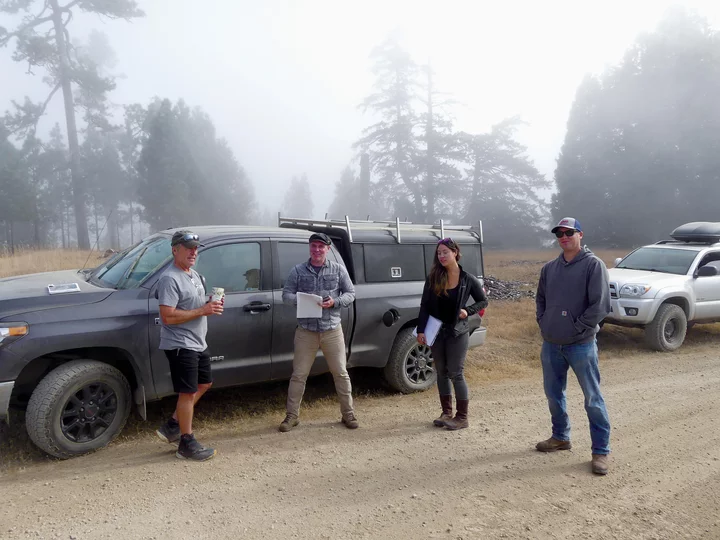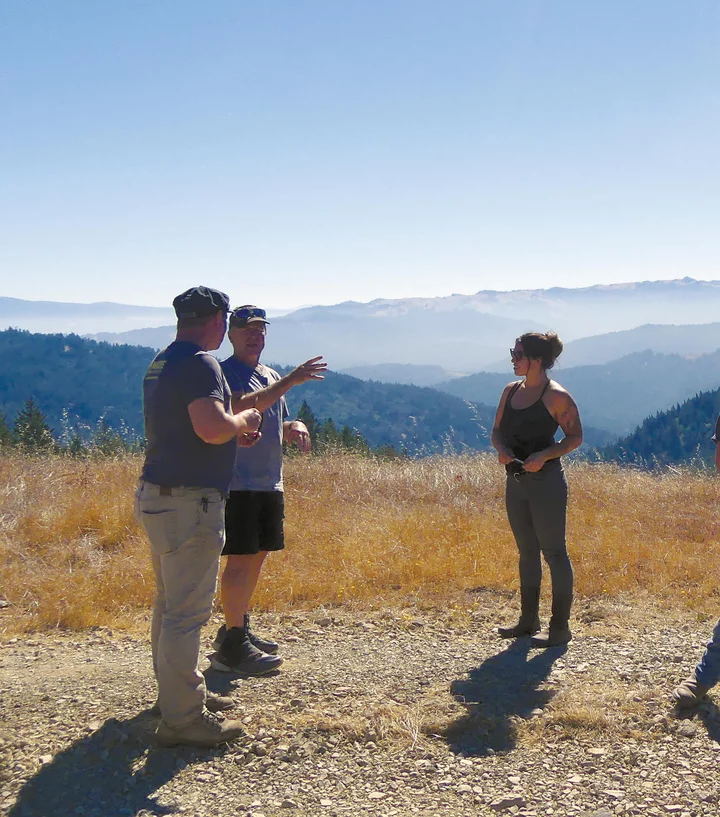(From left to right) Mark Chapman at a recent site visit at Chapman Ranch with Hugh McGee and Jordan Anderson of Mattole Restoration Council; and Jake Taulbee of Humboldt County Resource Conservation District. | Submitted.
###
Press release from the Trees Foundation:
CAL FIRE has entered into a nearly $5 million grant agreement with the Humboldt County Resource Conservation District (HCRCD) to implement the Mattole and Salmon Creek Forest Health and Wildfire Resilience Project across 1,022 acres of forest and grasslands near Petrolia and Salmon Creek by early 2026.
The project is designed to enhance forest health at the landscape level in the Mattole and Salmon Creek watersheds, ensuring that the areas treated will help meet emissions reduction targets of the California Climate Investment (CCI) program while critically reducing wildfire risk and contributing to the safety of local residents.
This project is a collaboration between state and local agencies, non-profits, and private landowners. The team of collaborators working on the project include CAL FIRE, HCRCD, Mattole Restoration Council, Humboldt Redwood Company, Trees Foundation, Mattole Salmon Group, Chapman Ranch, The Valley View Ranch, Cisco Benemenn, the 7B Ranch, the 3030 Ranch, and California State Parks.
“HCRCD is honored to administer this grant and facilitate this important work on behalf of the Southern Humboldt community,” said Jill Demers, HCRCD Executive Director.
“CAL FIRE Forest Health funding has created an incredible opportunity for us to implement landscape scale ecosystem restoration projects in the Mattole and Eel River watersheds,” said Hugh McGee of the Mattole Restoration Council, who led project design and will manage project implementation. “This project will address ecological issues across multiple ecosystems while building a local restoration workforce. Treatments will occur on ridgeline forests, grasslands, and oak woodland all the way down to riparian and in-stream areas. It’s unique to have one funding source address so many issues across different ecosystems, and we are really excited about that.”
Mattole Restoration Council worked with several landowners over the years to develop plans for forest treatments on Apple Tree Ridge and adjacent ridgelines on Humboldt Redwood Company property in the Mattole that will restore late seral forest conditions to the project sites.
The Salmon Creek shaded fuel break portion of the project centers around a forest treatment plan on the Chapman Ranch that was developed over a decade ago. The two projects were ultimately brought together under one grant proposal through a collaborative process that began in the fall of 2021, when Institute for Sustainable Forestry (ISF) teamed up with Trees Foundation to host a series of online meetings of Southern Humboldt-based stakeholders to explore potential projects for a regional CAL FIRE Forest Health Grant Program application.
This stakeholders group, now known as the Southern Humboldt Forest Health Collaborative, continues to convene to support the development and implementation of future projects that will benefit forest health and wildfire resilience in Southern Humboldt. The list of participants is still growing and has included CAL FIRE, Bureau of Land Management, California State Parks, Chapman Ranch, HCRCD, ISF, Mattole Restoration Council, Southern Humboldt Fire Safe Council, Trees Foundation, Salmon Creek Working Group, Southern Humboldt Prescribed Burn Association, The Watershed Center, Redwood Community Action Agency, and several Volunteer Fire Departments and interested community members.
“This is an exciting opportunity to promote forest management that contributes to the long-term ecological and economic wellbeing of our forested communities,” said Chip Tittmann, President of ISF. “I’d like to thank Tim Bailey of The Watershed Center for strongly encouraging us early on to pursue a CAL FIRE Forest Health grant.”
“In addition to promoting fire resiliency, California’s investment in forest health will benefit the economy,” said Gail Eastwood, Chair of the Southern Humboldt Fire Safe Council. “We can expect local workers and contractors to have ongoing employment in this satisfying work.”
“This grant is a major investment, not only in strategic forest treatments, but also in community planning and capacity-building that will help more southern Humboldt landowners to plan, fund, and implement fire resilience and ecosystem restoration projects on their own lands,” said Kerry Reynolds, Organizational Development Director of Trees Foundation.
Funding will be used for:
- Completing over 600 acres of forest thinning on Apple Tree Ridge and adjacent ridgelines on Humboldt Redwood Company property. Small diameter timber will be thinned on over 200 acres and sold to the mill for biomass utilization with proceeds offsetting project costs. The project also includes removal of encroaching trees from historical grasslands and oak woodlands, and installing trees with a helicopter in McGinnis Creek for in-stream salmonid habitat. In addition, the project will include invasive plant removal, native plant installation, and over 120 acres of prescribed fire in grasslands and forests.
- Completing a 200-acre shaded fuel break on the Chapman Ranch in the footprint of an emergency unshaded fuel break created during the 2003 Canoe Fire by CAL FIRE. The Canoe Fire burned more than 13,000 acres in California State Parks and encroached onto the Chapman Ranch, threatening the community of Salmon Creek.
- Completing surveys needed for State Parks to meet environmental compliance requirements to implement a future fuel break on the southern portion of their property that borders Chapman Ranch and the Salmon Creek watershed. As a project match, State Parks staff will assist in coordinating the necessary surveys and will also implement Phase 1 of their Watershed Resilience Project, also referred to as Panther Gap, which includes 150 acres of restorative forest and ridgetop thinning occurring largely in Middle Creek (middle Mattole River watershed).
- Community planning and project development in southern Humboldt County to foster local workforce capacity to implement forest health projects and support continued community engagement in strategic project development, ensuring that the impacts achieved under this grant will continue to expand across the southern Humboldt landscape into the future.
“Never before in our history have we had the opportunity to restore fire-suppressed landscapes at this scale,” noted Kyle Keegan, a member of the Salmon Creek Working Group. “I believe we can act accordingly and with care to utilize these grant funding opportunities to help build a lasting relationship to the land through the process of restoring fire resilience.”
For job openings or opportunities for licensed contractors connected with this project, email hugh@mattole.org or organize@treesfoundation.org. A community meeting about the Salmon Creek portion of the project will be held at the Salmon Creek School at 4pm on September 25.
The Mattole and Salmon Creek Forest Health and Wildfire Resilience Project is part of California Climate Investments, a statewide program that puts billions of Cap-and-Trade Program dollars to work reducing GHG emissions, strengthening the economy, and improving public health and the environment–particularly in disadvantaged communities. The Cap-and-Trade Program also creates a financial incentive for industries to invest in clean technologies and develop innovative ways to reduce pollution. California Climate Investments projects include affordable housing, renewable energy, public transportation, zero-emission vehicles, environmental restoration, more sustainable agriculture, recycling, and much more. At least 35 percent of these investments are located within and benefiting residents of disadvantaged communities, low-income communities, and low-income households across California. For more information, visit the California Climate Investments website at: www.caclimateinvestments.ca.gov.
(From left to right) Hugh McGee, Mark Chapman, and Jordan Anderson discuss work plans for a 200-acre shaded fuel break at the Chapman Ranch in Salmon Creek.


CLICK TO MANAGE